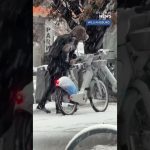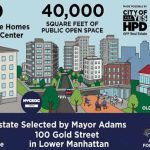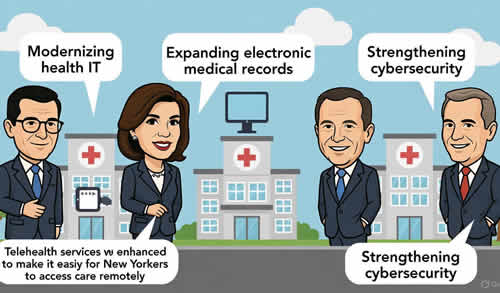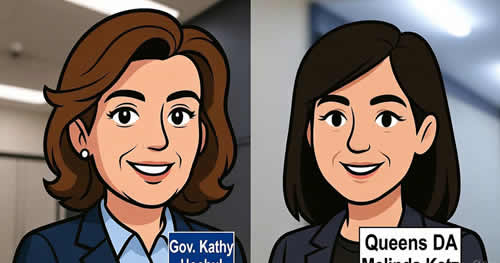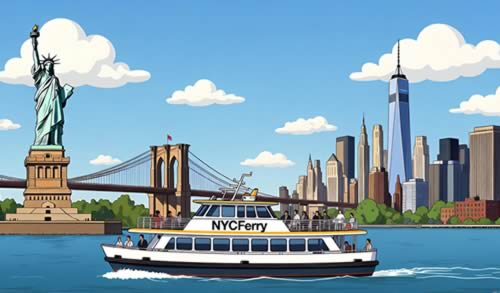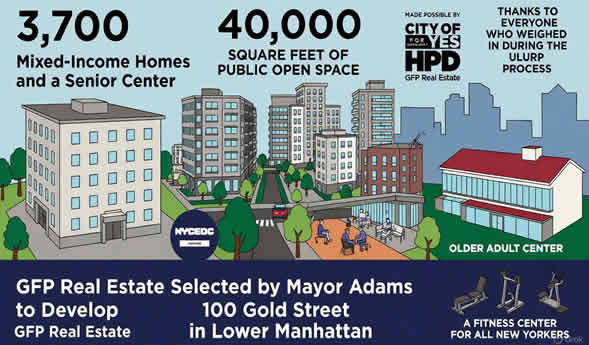New York City Mayor Eric Adams hosted his 19th Older Adult Town Hall, outlining key achievements in crime reduction, job creation, and affordable housing development. Addressing seniors directly, Adams emphasized his administration’s commitment to making the city safer and more livable for all residents. He highlighted a drop in crime, the removal of 80,000 illegal vehicles, and investments in senior housing and foster care programs. To enhance emergency preparedness, Adams introduced a new medical information card for first responders. The event reinforced his focus on direct communication and community engagement.
Mayor Adams Hosts Older Adult Town Hall
February 13, 2025
Mayor Eric Adams: Hello, how’s everyone? We have one rule, you do not stand for me, I stand for you. Good to see you. So much is happening in the city, and I love doing the senior-
Mayor Adams: –because it’s so important, and Commissioner Cortés-Vázquez and her team and all of our members who are here, thank you for coming out and sharing information with you. All I can say, I will bless the Lord all the time, and praise him every day. Praise him every day. And no one knows that better than you, because life gives us so many lessons. And when I sit down with my son and he talks about what he’s going through, I tell him that if you stay focused and believe in your faith, no matter what you go through, you know that God is still in charge. God is still in charge.
And so, this is number how many, commissioner? Number 19. This is our 19th older adult conversation. We do these town halls here in our centers because we want you to hear directly from me. We don’t want what we have done to be filtered by people who want to give the impression that our city has not come back.
When I became the mayor three years ago, we were having real problems with crime. We were having problems with scooters and dirt bikes riding up on our streets. Jobs were not here in our city. Our subway system was dealing with violence. Unemployment was high. Two years later, and now in our third year, we’ve built more affordable housing and housing in year one and year two, single years in our administration in the history of this city.
We have more jobs in New York for your children and grandchildren. More jobs in this city in the history of New York City. We dropped unemployment down, not only for Black and brown people, but all demographics in the city. We’ve invested in foster care children. We’re paying their college tuition, giving them a stipend, and giving them life coaches until they are 26 years old so they can understand the support that they can get from their family members.
We’ve invested in our older adults, building housing for you so you can remain in the city that you made what it is in the first place. We decreased crime, 20,000 illegal guns removed off our streets. Subway system, do you know we have 4.6 million people that ride our subways a day? Do you know we have an average of six felonies a day on our subway system? We’ve made our system safer, put hundreds of more cops in the system so you can be safe in the streets. And we have removed over 80,000 illegal vehicles off our streets because we heard you talk about the dirt bikes that’s on your sidewalks and you’re afraid to walk the street. So we removed over 80,000 illegal vehicles off the streets in the process. We’ve improved our healthcare system. We made sure that businesses are growing. More small businesses are opening the city and the history of the city. So we have been working hard for you. There’s so many things that we’ve done and we want you to hear it directly from us. That I loved this city when I was a police officer protecting you, when I was a state senator, when I was the borough president, and now as your mayor, I am committed to this city and making sure that this city is a place of opportunity for everyone. And that is why we come out, we speak directly to you so you can hear directly from your mayor.
This is an amazing city. This is the greatest city on the planet because we have the greatest people on the planet in New York. So I’m going to answer your questions, but I have this little magnetic strip of when my mother was with us before she transitioned. She was the one that gave me this idea. Whenever she had an emergency at home, we had to find her papers in a document. This is a little strip you can put on your refrigerator or anywhere, and it’s just your basic information, your name, your emergency contact number, your primary care, a doctor, any chronic condition you may have, any allergies, and any medication. So this way, if the ambulance or a first responder comes to your home, they can find this information. You won’t have to look it up. So the team is giving them out, we’re giving them out, right?
If you haven’t received one, you can raise your hand. Okay, the team will give it to you. I’m going to give you mine, and they’re going to give you the rest, okay? All right, so let’s make sure they give them out. But the team is here. We want to answer any questions that you have, but again, we look forward to a good, lively discussion with all of you, okay?
Where am I looking first, folks? Numero uno. How do you say table? Give me table in Spanish. Mesa? How are you, sir?
Question: Good afternoon, mayor. Welcome to the Sunnyside Center. My pleasure to talk to you in front. And we have a couple things, a couple suggestions for you. We can help us. The first one is this Sunnyside area is a very nice area, but right now, we have a problem with the removal of snow from the front of the houses or the business. So what I mean is how we can work with you about they need to clean it up because us, our age, we’re walking. And sometimes, we slip on the snow. So that’s the first thing. The other thing is now the people, the mechanics working on the street, no matter what day, what time, but they don’t repair the cars on the street. And sometimes, we can pass noise blocking. So that’s the two particular reason. It’s between around the 43rd Street, especially 39th, 44th, and 45th [street]. That’s the area I live with my family. Thank you very much.
Mayor Adams: So is the first thing you said, people are not shoveling their snow in front? Okay, is there a certain location where this is happening?
Question: This is happening, between the 43rd Avenue and all the streets, 45th.
Mayor Adams: So is that DSNY or who’s doing it?
Commissioner Lorraine Cortés-Vázquez, Department for the Aging: DSNY is not here, but we’ll take the information.
Mayor Adams: Okay, so we’re going to take the information, okay? And we’re going to look at that location where the snow is, and we’re going to look at the location where the captain inspector– chief, how you doing? We’ll talk about– you have the precinct? Let’s talk about those repair shops so we can do enforcement over there in the repair shop
Captain Hameed Armani, 108 Precinct, Police Department: Hey, good afternoon, everybody. I’m Captain Hameed Armani. I’m the new commanding officer. I got here last week. We’ll take your information. You cannot repair cars on the streets. It’s illegal. That’s the end of the story. We’ll take the location and we’ll address it right away, sir.
[Inaudible.]
Captain Armani: Yep, Detective Torres is going to come to you, give you all the information, and I’ll take it personally.
Mayor Adams: We’ll look at it. Yes, go ahead, sir.
Question: Do you have the phone number or any particular issue for, we can call. We can call when, so these three days, they not remove the snow from the house.
Mayor Adams: Yes, you can always call 311. Okay, call 311 and make the complaint, but we’re going to also go over and look at the locations you’re talking about, and we’ll make sure, people have to shovel this snow, I think it’s within two hours after it stops snowing. We will make sure we do spot checks in that area that you’re talking about. Okay. Muchas gracias.
Where are we? How are you?
Question: Good afternoon.I’m representing table number two. And today, they have a transportation question. There’s a need of an elevator at 40th Street Station Lowery due to the increase of older adults and people with disabilities.
Mayor Adams: Is there an elevator there now?
Question: No. Mayor Adams: Okay. I know the MTA, they have an entire plan of building out elevators throughout the city. We will look at if that is on their agenda. If not, we will bring it to their agenda. People don’t realize the mayor does not control the MTA. But we will take your concern and we will give it to them that we need an elevator. And I don’t know if that’s one of their locations they’re going to build out, but we will definitely advocate for it. And it’s on which, can somebody get this location?
Question: 40th Street Station.
Mayor Adams: All right, get it, 40th Street Station. What line is that?
Question: That’s a seven train.
Mayor Adams: Seven, okay.
Question: I also have a special message from one of our guests here, [Diana Cinch], have a thank you message for you.
Mayor Adams: Okay, this is Valentine’s Day, so you can say something sweet.
Question: Thank you, Mr. President– oh my God, mayor, here we go. We want to thank you for opening our senior center. This is our second house. We spent here all day. We have a great lunch, great activities. We learn a lot as a senior on the technology. We learn painting. Please keep our center open. Thank you.
Mayor Adams: Thank you. You want to respond to that, commissioner? And we agree with you. We know how important the older adult centers are. We know it’s a way to come together. It’s a way to socialize. And really, it’s part of the healthy environment when you not only eat well, you take exercise, you learn new things, it keeps your mind fresh, and it also allows you an opportunity to learn from each other. But our commissioner does an amazing job. You want to respond to that? Thank you.
Commissioner Cortés-Vázquez: Yes, first of all, we can’t do this without partners like Sunnyside, and [Judith], and [Jabong], and all of the people who make it possible. But this mayor made a commitment, and he made a commitment last year, when things were tough and the budget was very tight, that we would not close any aging services. And so that commitment still stands strong, but I’d never tell you, keep your fingers crossed, because our commitment is firm. We will not close older adult clubs at all. All right, thank you very much.
Mayor Adams: Thank you. Thank you for that. Where am I headed?Question: Good afternoon, Mr. Mayor. So one of the individuals at the table had a question. So according to the new administration in Washington, D.C., will there be any cuts regarding social services for the community?
Mayor Adams: Our goal is to advocate for every dollar for our city. We’ve done it under the previous administration. We’re going to do it under this administration. And as the commissioner stated, our commitment is to really hold harmless our adult senior care centers. And so we don’t know the full scope of what this administration is going to do, but we’re going to fight for every penny to make sure that New York gets its share.
We’re the economic engine for the state. We’re the economic engine for the country. I was just in Albany last week or a week and a half ago fighting for the dollars on a state level, and we’re going to continue to do that on the federal level as well.
Question: I also had another question. What can be done regarding the future of transportation for individuals getting into Manhattan? Considering the new congestion pricing, it is expensive for seniors and their family to take their individuals into Manhattan for emergency services or hospital visits. It is taking a toll on their pockets.
Mayor Adams: Yeah, and there are a few waivers we were able to fight for. I don’t know the quite list of those waivers, but what we need to do is find out what waivers are available for seniors. We need to make sure that all of our senior centers are aware what those waivers are.
The congestion pricing was passed by our state lawmakers. It was handed down to the MTA to the actual implementation of it, and it was our goal. We were able to secure $100 million for the areas for environmental issues so that it won’t be an environmental spillback, but there are a few waivers we were able to fight for. We will find out if those waivers impact our senior centers, so make sure that you’re aware of it at the same time.
Commissioner Cortés-Vázquez: Great. I believe there’s some for medical appointments, but I’ll confirm. Table four.
Question: Hi, good afternoon, everyone. How are you? My name is [Mamarta Reyes], and my question is, this is my second home almost. Every day I’m here, but the transportation, especially Q32 and Q60, are always late, and I have to wait 30 minutes to travel to come to the center.
Mayor Adams: What you take, you take Access-A-Ride?Question: No, Q32 and Q60.
Mayor Adams: Oh, the bus.
Question: Always late.
Mayor Adams: Yes. You know, and there’s several apps that they have that you can see when the bus is actually coming, and so we’ll get both those buses, and we will communicate with the MTA, who’s in charge of our bus system, and identify their reason they are late.
Now, one of the problems that we find is a lot of people park in bus lanes, a lot of people double park, a lot of people hold up and they drive in the bus lanes, so we want more enforcement in the bus lanes to make sure that they’re not slowing down the bus in the process. Now, what bus is that, by the way? Q32 and Q60. Okay, we don’t want it to be late. We want you to get here on time. All right, you take a note of that.
Commissioner Cortés-Vázquez: I want to just let you know that this came up in another part of Queens, and they gave us a slew of bus routes. We communicated that with the MTA, and we know that the problem has been mitigated, so that’s why these things are important.
Question: I’m good, public engagement unit in the house. Hi, Mr. Mayor. So the ladies wanted me to ask a question. My name is [Sarah]. It says, under the 40th Street and Lowery Subway Station are many homeless people who have made that station their home. They are urinating, defecating, sleeping, and using drugs at the station. What can you do about this to make it a safe place for us? And I’ll slide this in. And in addition, that station needs to have an elevator or escalator, because the seniors struggle to make those stairs.
Mayor Adams: And that’s the same 40th Street, same station? Okay, so what I’ll do when I leave here today, I’m going to drive by there to see the location where you’re talking about because we don’t want people sleeping on the streets. We were able to remove encampments all over our city. Our city, you don’t see encampments everywhere. You don’t see people sleeping in tents, cardboard boxes. I’ve been extremely, extremely focused on that. So I’m going to go look at that location. And captain, can we do some type of enforcement over there? So I’m going to go look at it today, and we’ll make sure we have some enforcement today. Question: Alright, so I’m asking a question for the table. One is, what can be done to increase funding for the home care department and home attendants, since they are very– they assist seniors that cannot go out?
Mayor Adams: This is increased funding for?
Question: So they have more work, more hours of work. You want to talk about that, commissioner?
Commissioner Cortés-Vázquez: Yeah, it’s one of the unmet needs that we’ve been challenged with. And as people are getting older, we know that people need more in-home services, so that our commitment as a city, and as this mayor has, is that people live in the communities that they build. So it is something that we have presented as an unmet need, and that we are looking at very seriously. So the answer is, we hear you, and we’re working on it.
Question: So happy to meet you.I’ve been around here for 47 years. And I was so happy for the job that you’re doing. When my sister told me, she rides the train, and she now can sit down on the train. Before, people were lying down there, and I was so happy for my sister also, she find where to sit down.
Mayor Adams: Yes, yes, love it.
Question: So I was 15 years as PTA. 17 years, 15, I think. So if [inaudible]. So, thank you, thank you.
Mayor Adams: De nada, de nada.
Question: I pray for you all the time. Good job.
Mayor Adams: You pray for me all the time? Thank you, the power of prayer. You know, we need each other’s prayers.
Question: Okay, I have, I mean, we have some concerns about Sunnyside. One of these is that there is no light on the streets.
Mayor Adams: Where, where?
Question: On Sunnyside. When we walk during nighttime, I see that everything is so dark. And of course, it is dangerous. Because, you know, many things can happen, crimes and this kind of thing. Even one person on this table, it was the person whotold me about it, and she told me that she was, you know, she was in danger from some people, and the place that she was walking was really dark. So I had noticed during the last years that Sunnyside is so dark that there is not enough light. This is one-
Mayor Adams: So hold on, I want to deal with that one first. DOT, I want to deal with the lights part. You heard the question?
Assistant Commissioner Kim Wiley Schwartz, Education and Outreach, Department of Transportation: I heard the question.So the Department of Transportation puts in lights. We’ve got these new LED, relatively new LED lights. I think the best thing to do is for me to sit with your table at the end and take some specific places where we can send out the Queensborough Commissioners group to do a survey and figure out how to fill in some of those gaps.
Question: I think most of Sunnyside is dark. Okay, another concern-
Mayor Adams: So she’s going to come over and find out the locations that you’re talking about that are dark, okay?
Question: Yes, I think all, I mean, the whole Sunnyside is very dark.
Mayor Adams: Okay, well, we’re going to look at some locations. Hold on, I want to make sure that you know that we want to deal with it, we’re going to look at some locations, okay? Because we cannot have a dark, sunny side. So we’re going to come over and we’re going to do a survey. Am I correct? We’re going to do a survey to see exactly where the problems are, okay? Okay.
Question: Another thing that I noticed during the last years is that there are a lot, a lot of rats.Mayor Adams: A lot of what?
Question: Rats.
Mayor Adams: Rats?
Question: Yes.
Mayor Adams: You know I don’t like rats.
Question: So when we are walking on the street, believe me, I am so scared. And really, it is very, you know, very, I forgot the word at this moment, you know, but there are a lot of rats on the streets. We are walking and we see rats running from everywhere. And I think that the garbage cans that are put in right now, I think that it is increasing the problem because these cans have a lot of garbage, so the rats get inside. Because I saw that, that where there are garbage cans on the streets, the rats come and there are more rats over there.
Mayor Adams: When they have the garbage cans, there are more rats or less rats?
Question: More, more rats.
Mayor Adams: More from the garbage cans? Why, why?
Question: Because the cans is full of garbage. So they come over there.
Mayor Adams: They can’t do what?
Question: The rats come inside the cans, the garbage cans, because there is garbage, so they love garbage. And they go over there and there are more. Even if, I live on 40th, and I see two cans almost on the corner, and I see a lot of rats.
Mayor Adams: So what are you saying? There shouldn’t be garbage cans or there should be garbage cans?
Question: No, I think the garbage cans are increasing the problem. They are increasing the problem because these garbage cans are full of garbage, so the rats come over there.
Mayor Adams: Okay, where’s my rat czar? We have a rat czar. Oh, come on, you asked a question and I want my rat czar to talk about it, okay?
Yeah, I got you. But let’s– you had a whole list there, you know? Hold on, let us deal with the rat one first, okay?
Kathleen Corradi, Citywide Director of Rodent Mitigation: Thank you, mayor. Thank you for the question. My name’s Kathleen Corradi and I’m the citywide director of rodent mitigation. And first I’ll start with the containerization. So right now under the Adams administration, 70 percent of our city’s garbage is required to be containerized.
And what we know, what the science tells us, is waste in containers is less accessible to rats. Less food for rats means less happy rats, less rats for our city. So that is what the science says. Containerization works to drive down rat numbers.
If you’re seeing rats in your neighborhood at certain properties, we have a robust Department of Health team that comes out with inspectors to inspect the property, identify what the conditions are that are supporting those rats, and then work with the property owners to address the issue.
So if there are corridors we want to tackle, absolutely. But I want to encourage folks, if you’re seeing issues related to rats or uncontained garbage, we want you to report that because we’re committed to get at those underlying issues that have allowed rats to thrive in our city. The mayor’s been very clear on his stance on rats. Now it’s our job to execute and make sure we get rid of rats in New York City.
Mayor Adams: Thank you. We want the garbage in containers. We don’t want the garbage in plastic bags. We don’t want it running around. We want the garbage in containers, and that’s what we’re moving towards doing.
Commissioner Cortés-Vázquez: Okay, the next table, table nine, and then we’ll come back if there is time. How are you?
Mayor Adams: Good, good to see you. Yes, yes. Is it on?
Question: Mr. Mayor, good afternoon. Thank you. Good afternoon, everybody, or everyone. I always come here to this community center because it’s lovely, the lunches is special and wonderful, and this is not my community. I live in Jackson Heights. The problem I have there is all these social workers grabbing everybody, even myself, asking me for a massage. It is impossible to walk the streets of New York, and we control this and we prepare a little bit for everyone as possible.
Mayor Adams: Yes, yes. What happened last year, Councilman Moya told me the same thing. I met him and his team over there around 1 a.m. in the morning, and there was so many prostitutes out on the street doing exactly what you stated, and the community was complaining because their children had to watch this.
It was taking down the quality of life of the area on Roosevelt Avenue. We went there, did an operation, a full out. We were able to really close down a lot of the massage parlors, a lot of the brothels, and it turned around that entire area. I went there last month, and new businesses are opening. It’s cleaner. Department of Sanitation went there to make sure that the streets remain clean, and so we’re going to continue to analyze and make sure it never goes back to the way it was before.
Question: I know, Mr. Mayor. I know you are doing, your administration is working over there, doing something good, because I can see it on the streets. Again, the sidewalks are cleaner. Not too many vendors anymore. Right. These girls, they come every single minute we live. So the police is not there anymore.
Mayor Adams: Right, and we’re going to stay on top of it.
Question: An hour later, they’re all over there again.
Mayor Adams: We’re going to stay on top of it. It’s unfortunate that some elected officials in your area believe that they should be allowed to do that, and I say no to that. I don’t believe in sex trafficking. I don’t believe that you should have someone on the streets walking and working like that. We’re going to do our job, and we’re going to continue to stay there to make sure that you can enjoy Roosevelt Avenue and the community.
Question: Wonderful. Thank you, Mr. Mayor.
Mayor Adams: Thank you, thank you. Thank you. Table 10. How are you, ma’am?
Question: Hello, Mayor Eric Adams. Thank you for coming to Sunnyside and listening to us.
Mayor Adams: Thank you.
Question: My question is, there are rules for the bicycle drivers in Sunnyside. I did this question because one friend who passed 80 years old crossed the green line and one bicycle driver hit him. He fall, go to hospital. He is alone. Many problems with him, and nobody say nothing. Thank you.
Mayor Adams: Thank you. Thank you very much. And DOT, you want to weigh in a bit? Bicycle riders must follow the same laws as car drivers. They have to follow the same laws. And we are increasing our enforcement because we don’t want people to feel afraid to walk the streets. It doesn’t matter if it’s a scooter, if it’s a car, if it’s a bike.
And we are increasing our enforcement, and we want to make sure that they ride in the bike lanes like they’re supposed to do. I’m a bike rider also. The overwhelming majority follow the rules, but there are those, like in anything, that don’t follow the rules, and we want to make sure we identify them. DOT, you want to add anything to that?
Kim Wiley-Schwartz, Assistant Commissioner, Education and Outreach, Department of Transportation: It would be my pleasure. So my name is Kim Wiley Schwartz. I’m the Assistant Commissioner for Education and Outreach, which means I’m in charge of all safety education for the city of New York. I don’t really sleep that well.
But just, that didn’t land, mayor. I thought I was going to get a laugh out of that one. But, so it is my job to make sure that we are communicating the rules of the road to bicyclists. And the only way that we can figure out to do that is literally go onto the streets.
So as we’re speaking today, I have a team at 116th in Harlem. I have some people on 4th Avenue in Brooklyn, and I have some folks that are sort of in a different area of Queens, more towards Main Street Flushing.
So we’re out on the street talking to people in languages that they understand, especially our delivery workers who did not receive the training that they should have been receiving from the app company. So we’re working on that.
The mayor has asked us to start a new team of NYPD and DOT safety education out on the street. We’ve been in areas of downtown Brooklyn, in hotspots in Manhattan, and near the Queensborough Bridge recently. So we’re working on this, but it is one step at a time. One step at a time. But we’re taking it very seriously.
Mayor Adams: So we want our streets to be safe. We don’t want someone being struck by a vehicle, a bike, a moped. And we’re very, very focused on making sure, particularly as older adults, or people who are living with some form of disability, they should not be fearful to cross our streets and to be able to walk in our streets. So we hear you loudly and clearly. Thank you. Thank you for your question. Number 11.
Question: Good afternoon. He’s going to ask it in Spanish, but.
Mayor Adams: Yes, yes. Okay.
Question: No, he’s too shy.
Mayor Adams: Okay.
Question: Okay. The thing is, we have two questions. So the first question is, how can we move the bike lane into side streets with less traffic and no voters’ riot? To be specific, it’s Queens Boulevard, 43rd Avenue, Skillman Avenue, and Northern Avenue. The second question is, from him, what’s going to happen to the crime on the streets?
Mayor Adams: What’s going to happen to the?
Question: What’s going to happen with the crime on the streets? Because according to him, he said that we feel so insecure on the streets.
Mayor Adams: Someone stole something from him on the street?
Question: Yes, yes, two times.
Mayor Adams: Two times? To him. Well, I’m sorry to hear that. Can we talk about the bike lanes and how we place the bike lanes? It’s been a DOT bike lane conversation today.
So you want to go into that a little? How do we decide where we place them? So, we need a mic. Who has the mic? And captain, chief, you can go into the crime after. So she wanted to know how do we place them, why we don’t place them on the side street, et cetera. What’s our science behind the placement of bike lanes?
Wiley-Schwartz: Oh, yes. So we have a bike network, right? We’re trying to build out a bike network, especially so that folks from this area can use bicycles to do business all the way down and all the way into the Central Business District in Manhattan.
These placements are intentional to try to make them in places where you’re also likely to see busy traffic, car traffic, right? So as older New Yorkers, I’m worried that you’re going to be struck by a dangerous driver. And so these places where we have heavy traffic and places where we put bike lanes because we know that pedestrians have to, that’s where we want to center the traffic of all different modes in the same places and also fill out the bike network to make sure that people can get where they need to go. So there is a lot of intention to this. However, we need to continue to get the behavior we need for both drivers and bicycle riders.
Commissioner Cortés-Vázquez: I’m going to take a minute to translate thatas best as I could, all right? Okay.
Voy a tratar de traducir lo que ella dijo para que usted tenga la información necesaria. Es un plan. Adonde se ponen esos [carriles] es muy importante porque la intención es que el ciclista pueda caminar en el condado y también entre condados. So hay un plan especifico para eso. Pero también, como dijo mi colega Kim, lo importante es que tenemos que educar a los ciclistas y también a la gente que andan en la calle. Porque es bien importante que ambos sepan cuáles son las reglas. Pero si tienen un problema especifico, pueden hablar con Kim y ella puede hablar con usted de cuál es el plan y cómo se desarrolló eso en esta área. Okay? Entendido?
Translation: I will try to translate what she said so that you have the necessary information. It’s a plan. Where these lanes are placed is very important because the intention is for the cyclist to be able to walk within the county and also between counties. So there is a specific plan for that. But also, as my colleague Kim said, the important thing is that we have to educate cyclists and also people who are on the street. Because it is very important that both know what the rules are. But if you have a specific problem, you can talk to Kim and she can talk to you about what the plan is and how that played out in this area. Okay? Understood?
Mayor Adams: And so, chief, you want to go into the crime? You want to translate? The chief is going to talk about crime.
Commissioner Cortés-Vázquez: Right [Correcto]. Entonces, vamos para el asunto del crimen. Vamos a tener nuestro….
Assistant Chief Brian Hennessy, Patrol Borough Queens North, Police Department: Yep, we’re good. Thank you, Mr. Mayor. Sure, sure. First and foremost, my apologies that you are a victim of a crime in this neighborhood. Crime in this precinct last year was down overall 5 percent, but I know that doesn’t mean anything to individual victims of crime.
Question: [Inaudible.]
Assistant Chief Hennessy: We take crime against our older residents very, very seriously. I am a Queens resident, like all of you. I’ve lived here for 48 years. Jackson Heights, my mother was born right off Roosevelt Avenue on 95th Street. I live here, I was a commander here. Crime and quality of life issues are extremely important to me.
Question: [Inaudible.]
Assistant Chief Hennessy: This is one of the safest precincts in the Queens North. We have eight precincts that we cover. However, one crime is one crime too many. Our older residents that are victims of crime, we visit personally. Our crime prevention officer, our community affairs officers go to the precincts. We go to the precincts. Our crime prevention officer, our community affairs officers go out. They speak to them individually regarding services and just follow up with their health and if there’s anything they can do.
Mayor Adams: And we also, with deputy commissioner of Community Affairs, Commissioner Stewart, what he has done, he has put an older adult liaison in every precinct. Who’s it? Do we have the one that’s here for this precinct? Okay. Why don’t you come identify yourself?
Detective Marcos Torres, Community Affairs, Patrol Borough Queens North, Police Department: Hello, I’m Detective Torres. I know familiar faces to everyone here and been here many times. I’m under community affairs officer, our crime prevention officer. He’s on vacation this week, which is George Perez. I’ll be more than happy to talk to you, sir. And we’re here at the 108, we’re here to help anyone here. If there’s anything you’re in need, especially the elderly, we’ll be more than happy to assist you in any way.
Mayor Adams: So every precinct has an older adult liaison. So if you need follow up, let him know if he needs follow up on the crime report, what is the outcome of his case, whatever information you need, that’s what we want you to do to speak with the older adult liaison in the precinct.
Q: My name is []. My question is for me, I know that for many people too, we have concerns. Why give so much financial help to so many people who really don’t need it. Young people, people who can work who go and exchange food stamps for beer and money to make life easy, live easy and happy, have fun. Why not invest this money in people who really need it, disabled people, sick people. And especially to our adult people who need it so much and have worked so hard for their entire lives to have a happy ending. That’s my question.
I am studying to become a citizen and I hope this does not take away my citizenship. Thank you.
Question: I am translating for [Ms. Aracelis]. So her question was, what is the city doing to help assist seniors, older New Yorkers, to obtain more social services? She mentioned that she is seeing that there are younger people who are able-bodied to work who are obtaining more social service needs.
And she just feels that for older New Yorkers, there’s not enough social services available to them. And she also added that she’s in the process of becoming a US citizen, and she hopes her comment doesn’t jeopardize her impending citizenship. So that was her question.
Mayor Adams: No, no. And no matter who you are, you have the right to share your opinion. You’re gonna translate for me, okay? Yes, yes, yes. Tell her no matter who she is and what her status, she has a right to share her opinion.
Question: : The mayor said his opinion doesn’t matter. That’s your opinion. And that will not harm her immigration process as she is an American citizen. So don’t worry. You are protected.
Mayor Adams: And congratulations on getting your citizenship.
Question: : And congratulations on obtaining your citizenship.
Mayor Adams: Thank you. Commissioner, you wanna talk about the services for older adults? Yes.
Commissioner Cortés-Vázquez: : Firstly, for us, in this city, we have two communities that are extremely important. Our young people and our older adults. So I don’t want you to think, service for one does not give you the opportunity to have services for another. All right? So that’s very important. We are always ensuring that services for the elderly are there. We are also very aware that the needs are growing every time. But a commitment has been made that services for older people will be maintained. For us it is very important. But it is very important that we also, as a citizen of this city, never say that for children less, for the elderly it is more. Because for us, both are very important.
Commissioner Cortés-Vázquez: I’ll tell you what I said. I said, in this city. In this city, we never talk about services for one versus services for the other. That is very important for us, because services for one does not preclude or prevent services for the other. So for us as a city, these are two anchor communities, and we want to make sure that they do. And we’ve had a commitment that older adult services will be maintained.
Mayor Adams: Well said. Thank you.
Mayor Adams: Hello, nice to meet you. Yes, yes.
Question: My name is Rosalina. I live in the neighborhood over 60 or 70 years. I’m 92 years old.
Mayor Adams: Wow, 93, you said 93?
Question: 92.
Mayor Adams: 92, wow. Wow.
Question: The reason I say that is because I want to thank your Police Department, one-way [inaudible]. They keep us very safe, I think. I go out at 8 o’clock at night, come back 9:30, walk in Greenpoint Avenue, I feel very safe. So I want to give thanks for that, okay? So no problem with the one-way [inaudible]. They’re very good.
Mayor Adams: Wow. Thank you. First of all, you are a blessing, 92 years old, wow, love it, love it. Love it, ma’am, you had a question? You had a question? I thought I was going to come back to you.
Question: Yesterday, I fell on the street. The sidewalk, the sidewalk at the street, there was a pile of snow. Because they push the snow at the edge, and they don’t make a little space for the people to go through. And that’s happened when the bus stop, the stop, you can’t go through the street. Right, right, right. You have to follow the road at the corner. Sometimes the bicycle come in the corner and stops.
Mayor Adams: Sorry, sorry that you fell. And we haven’t had a lot of snow this year, matter of fact, for three years. But when we get it, we got to get used to it, and you should walk carefully in the snow. People are supposed to, as was mentioned, people are supposed to clear up in front of their homes, their businesses, and we want to maintain and make sure they do that.
Question: [Inaudible.]
Mayor Adams: Now I agree with you, I agree, it’s one of those random things. Wait, did we get everyone? Just one thing. Yeah, hold on, hold on. Commissioner, Deputy Commissioner Stewart.
Deputy Commissioner Stewart: Good afternoon. Always a pleasure to be here. So I want to share a quick story. Yesterday, I went to visit my mother, who’s 87. She told me last week, somebody called her on the phone and told her that they want to cut the lights off. And she had to go to Walgreens with $400 and use a QR code.
I don’t think my mother knows what a QR code is, but she ran to Walgreens with this scam. So last year, with my unit, our crime prevention unit, we did over 1,200 scam alerts for older adults. That’s my captain there, his name is Captain Papadopoulos. I probably was saying it wrong for three years, I call him Captain Sparrow. We have a scam alert that’s going to be done here on February 20th at 1 o’clock. So I advise that everybody should be here, learn about the new scams and what these people do. If they do ten scams and they get one person, that’s a good day.
So I definitely send that everyone show up at this process. I also have my self-defense detective there. We’re going to set up something with Judith, I guess, to do a self-defense class that we also do for older adults. I think last year, how many did we do? 60, and that’s citywide. So these are just some of the terms that the Police Department has that’s in effect. And we also, you’re about the liaisons and the precincts. So we’re going to do a self-defense class and a crime prevention class in this building, okay? Thank you.
Mayor Adams: Thank you, thank you. So I hope everyone heard what Commissioner Stewart stated. There’s so many scams. There’s so many scams that people focus on older adults. There’s so many scams. They knock on your door and say they have to check your electric meter. They’ll go inside and someone will steal something. They will call you and tell you to wire money somewhere or to go to Western Union.
So what he’s going to do, he’s going to come out and give a lesson on some of the scams that are taking place. So you will know and be aware of them when they attempt to do so, okay? So what date is that again, commissioner? February 20th? February 20th, 1 o’clock, come out so that you can be informed. Because if you’re informed, you prevent the scams from taking place. You wanted to add something, ma’am?
Question: Buenas tarde Mayor [Adams]. Mi pregunta es y, de antemano, para pedirle de favor a usted que ayude a tomar acción en esto que es muy muy importante. No quiero que haya víctimas. Yo vivo en Woodside y le quiero dejar saber a nuestra autoridad en Nueva York que hay un árbol que está a punto de venirse arriba de mi casa o de la vecina de otro. Como cinco casas va afectar el árbol. Yo le he llamado la atención al dueño de esa casa que haga quitar el árbol, que trabaje con el árbol porque nos va matar a muchas familias. Y no ha hecho nada ese señor.
Le dejé mensajes en la puerta y tampoco me ha respondido. Entonces yo estoy muy preocupada y los demás vecinos. Por favor, que se puede hacer Mayor [Adams], por favor. Le pido encarecidamente que nos ayude en esto porque somos muchas familias [en] que pueden [haber muertes fatales] ahí con todas las familias.
Translation: Good afternoon, Mayor [Adams.] My question is, in advance I would like to ask you to help take action on this. It’s very important, I don’t want there to be victims. I live in Woodside, and I want to let you know, our New York authorities, that there is a tree that is about to come [down] [on top of my] house or [to] the neighbor’s house. About five houses are going to be affected by the tree. I have called the owner of that house to remove the tree, to work with the tree, because [it’s] going to kill many families, and this man hasn’t done anything. I left messages on the door, and he hasn’t answered me either. So I’m very worried, and the other neighbors, please, what can we do, Mayor [Adams], please, I beg you, help us with this, because there are many families that could have fatal deaths there, with the whole family.
Translator: Okay, so what she’s asking is that where she lives, there is a tree that is about to fall in her house, and it’s going to affect several houses besides her. It’s like three or four houses that are going to be affected if the tree falls. So she has tried to address it with the owner to see if he can call or do something, but he hasn’t done anything. So she wants to find out if there’s anything that can be done, or if you [can assist] with that. If not, because if the tree falls, it could kill or affect a lot of families, so.
Mayor Adams: Okay, so let her know that what I’m going to do is I’m going to have a commissioner come out to see the [inaudible] Department of Parks, [inaudible].
[Crosstalk.]
Question: En la yarda de la dirección, yo la tengo. Detrás de la casa.
Translator: In the Backyard.
Mayor Adams: Okay so tell her to give Tommy your information and address and we’re going to have someone come out and look and see how we can fix the problem.
Translator: Él me dijo que le de esta información al caballero para que vaya a mirar que se puede hacer para ayudarlos.
Translation: He told me to give this information to the gentleman so he can go see what can be done to help them.
Question: Por favor mayor, estoy muy agradecida de todo esto, a nombre de toda mi vecindad de Woodside.
Translation: Please mayor, I am very grateful for all of this, on behalf of my entire Woodside neighborhood.
Translator: She wants to thank you for everything, on behalf of her neighborhood.
Mayor Adams: Okay, thank you so much. Happy Valentine’s Day.
Source: NYC.gov; Midtown Tribune
Big New York news BigNY.com
#MayorAdams #NYCSeniors #PublicSafety #AffordableHousing #NYCLeadership #CrimeReduction #JobGrowth #SeniorLiving #NYCProgress #CommunityEngagement #UrbanDevelopment
